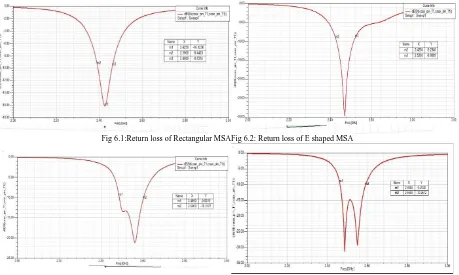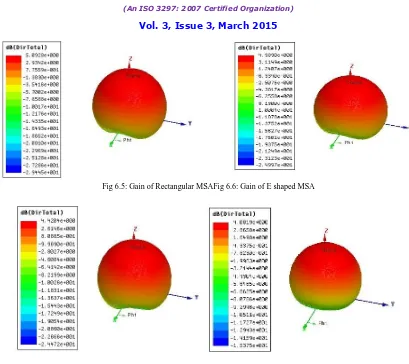Broadband Double Psi (Ψ) Shaped Patch
Antennas for Wireless Communications
Kavita Gundappa Talandage
1, DR. U. S. Sutar
2Dept. of Electronics, AISSMS’s COE, Savitribai Phule Pune University, Pune, MH, India1
Head of Department, Dept. of Electronics, AISSMS’s COE, Savitribai Phule Pune University, Pune, MH, India2
ABSTRACT: This paper presents the increase in bandwidth of a microstrip antenna using a simple slotted structure in microstrip antenna. The main aim of proposed work is to obtain a large bandwidth antenna with reduced size. A new double Ψ -shaped microstrip antenna is presented, which increased the bandwidth of the E-shaped microstrip antenna by cutting an additional pair of two slots on the other radiating edge of the E-shaped patch. The double Ψ -shaped patch yielded 135 MHz bandwidth at a centre frequency of 2.4 GHz with 4.0db gain. The proposed antenna is designed and simulated on the HFSS software.
KEYWORDS: MSA;DoubleΨ -shaped microstrip antenna; HFSS;Bandwidth; Gain;Dual parallel slots; Modes. I. INTRODUCTION
The field of wireless communication demands simple, small, reliable, economical, low profile and lightweight and mechanically robust antennas for various applications like mobile and satellite communication, phased array, electronic warfare, radar, missile telemetry, space and airborne microwave remote sensing systems etc.
With the development of MIC and HF semiconductor devices, microstrip and printed circuits have drawn the maximum attention of the antenna community in recent years.
In spite of its various attractive features like light weight, low cost, easy fabrication, conformability on curved surface and so on, the microstrip element suffers from an inherent disadvantage of narrow bandwidth and low gain.
Several techniques are available in literature for improving the bandwidth of microstrip antennas such as the use of impedance network, parasitic patches stacked on the top of main Patch, incorporating slots using multimode resonators etc.
1. Necessity:
Among these the slotting technique is simple to enhance the bandwidth as compared to the other techniques because it has the freedom to add desired slot on the radiating element of the Microstrip antenna.
The slots in the Microstrip patches may be of various shapes like U-slot, E- shaped slot, L-shaped slot, W-shaped slot etc.
That’s why in this paper we propose a modified psi shaped microstrip antenna which will increase the bandwidth by incorporating the higher order modes.
2. Objectives:
The objective of proposed system is as given below
To design a rectangular microstrip antenna for the ISM band (2.4 GHz).
Incorporate the slots and see its effect on the different parameters like bandwidth, gain, VSWR, radiation
pattern etc.
Optimize the design for the accurate values.
Obtain the increased bandwidth comparable with gain and size of the antenna.
II. HISTORYOFMSA
antennas are the most common types of antennas with wide range of applications due to their apparent advantages. They have been widely engaged for the civilian and military applications.
The technological advancement of the microstrip antenna is increasing day by day. A lot of research work is going on microstrip antenna for its better utilization in the future. Many techniques are coming into existence by compensating the gain and bandwidth of the Microstrip Antenna.
III.LITERATURESURVEY
Deshmukh A. A, et al. [1] presented the paper “Analysis of Broadband Psi (Ψ)Shaped Microstrip Antennas”. The Ψ -shaped patch yielded a bandwidth of nearly 60% at a center frequency of around 5500 MHz. It gave a maximum gain of more than 10 dBi, which reduced to less than 4 dBi towards the higher frequencies of the bandwidth. A proximity fed design of the Ψ -shaped patch in the 1000 MHz frequency band was also proposed. It gave a bandwidth of more than 50% with a broadside radiation pattern, and a gain of more than 8 dBi over the complete bandwidth.
A.A.Deshmukh and coauthors have presented the analysis of broadband pair of slot cut equilateral triangular microstrip antenna. They have realized the antenna with slots having different shapes like, U-slot, V-slot and rectangular slot at an appropriate position inside the patch [2].
To the improve the bandwidth of a micro-strip antenna used in sensing moisture contents in materials, such as soil and concrete, a design method of circular double-layer micro-strip antenna is studied in this paper. The antenna band is greatly improved by introducing a passive patch which meets working band requirements of the microwave moisture sensor. The numerical simulation results agree with the designed parameters [3].
In this paper Deshmukh A.A, et al. [4] presented a broadband configuration of a shorted-plate folded L-slot-cut folded-feed rectangular microstrip antenna was reported, which gave a bandwidth of 2840 MHz (133%). The broader bandwidth was obtained due to the coupling between various modes, which were either a half-wave or a quarter-wave in length. Also explained how we can obtain increased bandwidth of 3504 MHz (139.2%) by optimizing the folded feed length, Over the bandwidth, this configuration showed a radiation pattern with higher cross-polarization levels and with a gain of more than 5 dBi.
The design and experimental of a broadband coplanar waveguide (CPW)-fed hexagonal slot array patch antenna has been explained here. The results of the return loss (S11), gain and radiation pattern of the proposed antenna have been simulated by using antenna analysis software IE3D program. The transmission line and ground plane have been designed to be on the same plane with antenna slot to be applicable for wideband operation. It is found that the proposed antenna is accessible to bandwidth about 107.69%, a very large bandwidth comparing with conventional microstrip antennas, which mostly 1-5% bandwidth [5].
The analysis to study the effects of slot on the broadband response of slot cut patch is presented in this paper. Through the analysis it was observed that the slot modifies the resonance frequencies of higher order modes of the patch and yields broadband response. The bandwidth of more than 550 MHz (>; 45%) is obtained. The antenna gives broadside radiation pattern with a gain more than 5 dBi over the operating bandwidth [6].
Deshmukh, A.A. presented by using a combination of the proximity feeding technique and a thicker substrate, various broadband configurations of gap-coupled rectangular microstrip antennas, E-shaped and half-E-shaped microstrip antennas, and gap-coupled half-E-shaped microstrip antennas are proposed. All of these configurations give bandwidths in excess of 350 MHz (> 35%), with gains of more than 7 dBi, in the 800 to 1200 MHz frequency band, with a broadside radiation pattern [7].
IV.ANTENNADESIGN
A. Essential three design parameters:
•
Frequency of operation (f o): The resonant frequency of the antenna must be selected appropriately. The resonant frequency selected for design is 2.4 GHz.• Dielectric constant of the substrate (ε r): The dielectric material selected for design is glass epoxy which has a dielectric constant of 4.4.
• Height of dielectric substrate (h): For the microstrip patch antenna to be used in cellular phones, it is essential that the antenna is not bulky. Hence, the height of the dielectric substrate is selected as 1.6 mm.
B. Design steps for Rectangular Patch Antenna for 2.4GHz(ISM band): Step 1: Calculation of the width of Patch (W):
The width of the Microstrip patch antenna is given as
eq. (4.1) Step 2: Calculation of effective dielectric constant:
Fringing makes the microstrip line look wider electrically compared to its physical dimensions.Since some of the waves travel in the substrate and some in air.
An effective dielectric constant is introduced, given as:
eq. (4.2)
Step 3: Calculation of Length of Patch (L): The effective length due to fringing is given as:
Due to fringing the dimension of the patch as increased by ΔL on both the sides, given by:
Hence the length of the patch is:
L= Leff-2ΔL eq. (4.3)
Step 4:Calculation of Substrate dimension: For this design this substrate dimension would be Ls =L+2*6h
Ws =W+2*6h eq. (4.4)
Step 5:Calculation of feed point: For this feed would be given by
L/4 eq. (4.5)
V. SOFTWAREREQUIREMENTS
A. ANSYS HFSS v11 for Antenna Simulation:
ANSYS® HFSS™ excels at a wide variety of high frequency, full-wave, electromagnetic applications including antenna design and placement since it uses multiple advanced solver techniques to simulate not just the antenna but also the effects of its interaction with the entire system, including the feeding system as well as the platform.
A key feature of HFSS is automatic adaptive mesh refinement which generates an accurate solution based on the physics or electromagnetics of the design. Principles of open source development.
VI.RESULTANALYSIS
A. Measured return Loss:
The bandwidth and gain of the antenna for the designed modified Psi shaped antenna has been analyzed.
Below comparison table shows that the bandwidth of an antenna has been increased for the proposed antenna comparable to gain.
From the return loss performance we can see that the antenna operating bandwidth extends from 75 to 135 MHz.
Fig 6.1:Return loss of Rectangular MSAFig 6.2: Return loss of E shaped MSA
Fig 6.3:Return loss of Psi shaped MSA Fig 6.4: Return loss of modified shaped MSA
B. Measured Antenna Gain:
Fig 6.5: Gain of Rectangular MSAFig 6.6: Gain of E shaped MSA
Fig 6.7: Gain of Psi shaped MSAFig 6.8: Gain of Modified Psi shaped MSA
C. Comparisons of different shapes in MSA:
Table 6.1 gives the comparison between the different shapes of antenna. The double Ψ -shaped patch yielded 135 MHz bandwidth at a center frequency of 2.4 GHz with 4.0db gain.
Table 6.1 Comparison table for different shapes in MSA
Sr.No Shape of Antenna Frequency (GHZ)
VSWR Bandwidth (MHZ)
Directivity (dB)
1. Rectangular MSA 2.39-2.46 1.38 70 5.0
2. E shape MSA 2.42-2.51 1.07 90 4.9
3. Psi shape MSA 2.48-2.60 1.20 120 4.5
4. Modified psi MSA 2.46-2.59 1.05 135 4.0
VII. CONCLUSIONANDFUTUREWORK
-shaped micro strip antenna in the 2.4GHz frequency band were proposed. They yielded simulated bandwidths of more than 130 MHz with a broadside radiation pattern and a maximum gain very close to 4.0 db.
REFERENCES
1. Deshmukh, AA; Ray, K.P., "Analysis of Broadband Psi (Ψ)-Shaped Microstrip Antennas," Antennas and Propagation Magazine, IEEE, vol.55,no.2, pp.107,123, April 2013.
2. Deshmukh, AA; Jain, AR.; Ray, K.P., "Analysis of broadband pair of slot cut equilateral triangular microstrip antenna," Advances in Technology and Engineering (ICATE), 2013 International Conference on,vol., no., pp.1,6, 23-25 Jan. 2013.
3. Zhang Yong; Liu Ce; Guo Chen; Li Ting, "Design and analysis of a circular double-layer broadband microstrip antenna," Cross Strait Quad-Regional Radio Science and Wireless Technology Conference (CSQRWC), 2011 , vol.1, no., pp.334,336, 26-30 July 2011.
4. Deshmukh, AA; Ray, K.P., "Analysis of shorted-plate compact and broadband microstrip antenna," Antennas and Propagation Magazine, IEEE, vol.55, no.6, pp.100,113, Dec. 2013.
5. Pimpol, S., "Design and experimental wideband hexagonal slot array patch antenna," Electrical Engineering/Electronics, Computer, Telecommunications and Information Technology (ECTI-CON), 2011 8th International Conference on, vol., no., pp.196,199, 17-19May2011. 6. Deshmukh, AA; Vivek, D.; Darpan, S.; Sagar, K.; Ray, K. P., "Broadband proximity fed modified rectangular microstrip antenna,"
Communication, Information & Computing Technology (ICCICT), 2012 International Conference on , vol., no., pp.1,5, 19-20 Oct. 2012. 7. Deshmukh, AA; Ray, K. P., "Broadband Proximity-Fed Modified Rectangular Microstrip Antennas," Antennas and Propagation Magazine,
IEEE, vol.53, no.5, pp.41,56, Oct. 2011.
8. Deshmukh, AA; Parulekar, M.; Kadam, S.; Kadam, A; Ray, K. P., "Broadband proximity fed modified E-shaped microstrip antenna," Communications (NCC), 2011 National Conference on, vol., no., pp.1, 5, 28-30Jan.2011.
9. Wang Li-ping; Liao Cheng; Chang Lei; Gao Qing-min; Yang Qun, "Analysis and Design of a Novel Broadband Aperture-Coupled Microstrip Antenna," Intelligent Computation Technology and Automation (ICICTA), 2011 International Conference on , vol.2, no., pp.447,450,28-29March2011.
10. Weigand, S.; Huff, G.H.; Pan, K.H.; Bernhard, J.T., "Analysis and design of broad-band single-layer rectangular U-slot microstrip patch antennas," Antennas and Propagation, IEEE Transactions on, vol.51, no.3, pp.457, 468, March2003.
11. Cock, R.T.; Christodoulou, C.G., "Design of a two-layer, capacitively coupled, microstrip patch antenna element for broadband applications," Antennas and Propagation Society International Symposium, 1987, vol.25, no., pp.936, 939, 15-19 June 1987.
12. C. A. Balanis, Antenna Theory: Analysis and Design, Second Edition, New York John Wiley & Sons Ltd., 1997.

